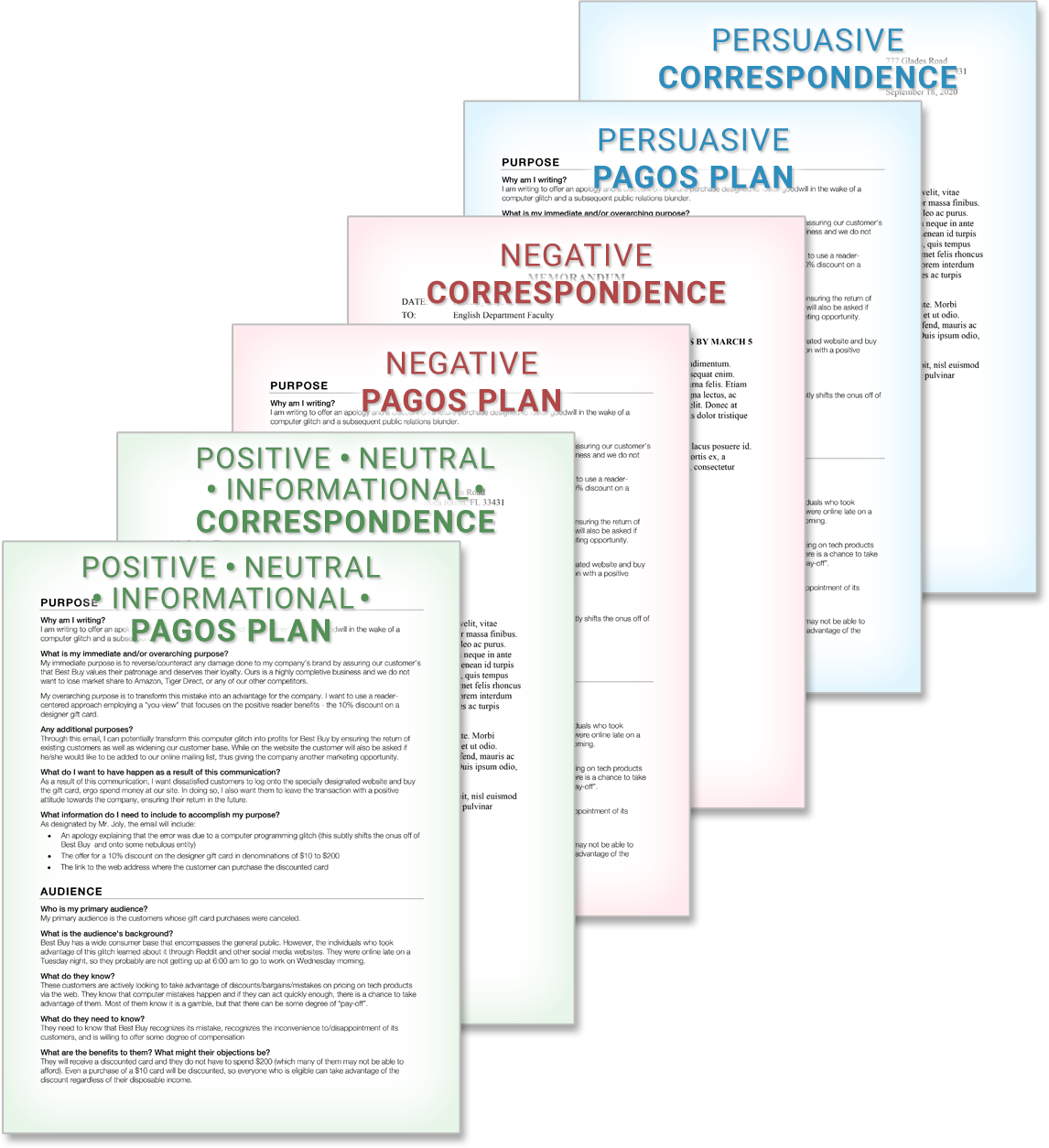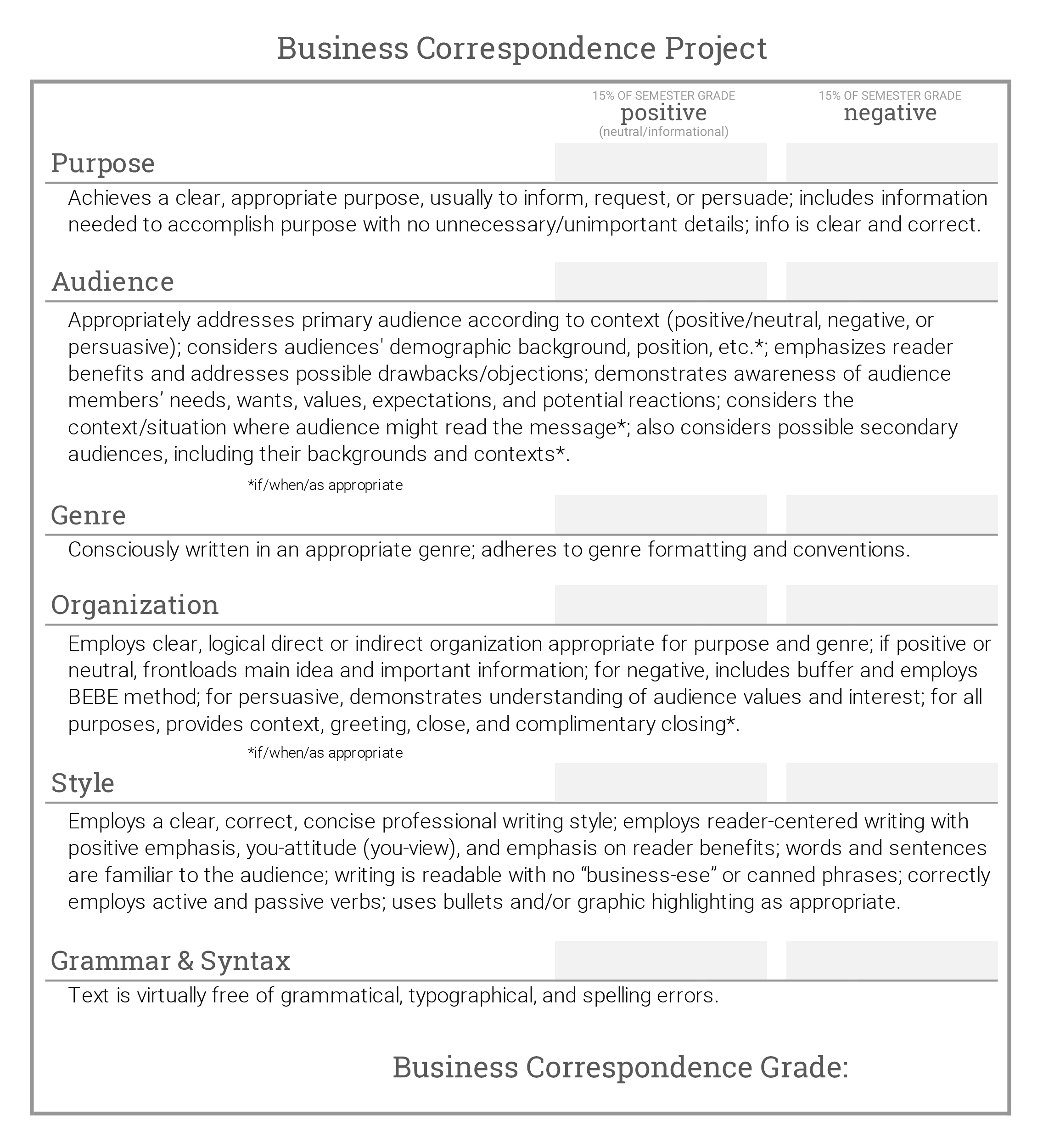PROJECT OVERVIEW & INFORMATION THE Business Correspondence Project (BCP)
BCP Project Overview
Correspondence is the foundation of business communication. In careers across the disciplines, correspondence such as memos, emails, and letters make up the majority of documents professionals produce during their employment. In class and in course material, you will learn about contexts/purposes for writing (positive/neutral/information, negative, and persuasive), short correspondence genres (memos, emails, and letters), and strategies for communicating effectively within them.
The Business Correspondence Project (BCP) will ask each student to plan for and write correspondence in response to a positive/neutral/informational scenario and a negative scenario (time permitting, a persuasive scenario). The particular scenarios each student will write to will be determined by their character. Summer 2025 character assignments are available on Canvas.
BCP Scenarios
The particular scenarios each student will write to will be determined by their character.
BCP Deadlines & Schedule
All BCP deadlines for any/all BCP material will be listed on the Canvas Course Schedule.
BCP Characters
For the BCP, each student will be assigned a character. The character—Michael, Dwight, Jim, or Pam—will determine the particular positive/neutral/informational, negative, and persuasive contexts each student will write within for the BCP.
*To be clear, you should NOT write as a character from The Office. In other words, don’t pretend you are Michael, or Pam, or whomever—the characters are just a way to assign different contexts to different people.

Expectations:
In general, you are expected to employ strategies you’ve learned from course material. Specifically, you are expected to
- Create thorough PAGOS document plans and employ a rhetorical approach to guide your decisions about how and what to write in your correspondence.
- Write effective correspondence that achieves the purpose outlined in the scenario text; achieves the goals of positive/neutral/informational, negative, and persuasive contexts; meets the needs of the audience, etc.
- Use reader-centered writing—you view, positive emphasis, reader benefits, and readers’ language—with special considerations for negative situations/information, reader benefits, etc.
- Write with the goals of professional writing in mind:
- Clarity – Be clear about your reason for writing, what you want to have happen, what you want the audience to do, etc. Ideas, paragraphs, sentences, and words should aim for clarity.
- Conciseness – Use strategies for concise writing.
- Correctness – Writing should be grammatically correct, employ parallelism, and demonstrate effective professional writing style
- Write, organize, and format documents according to the conventions of their genre and purpose. In other words, letters should look like letters, memos should look like memos, and emails should look like emails. Memos and emails (and, if you decide, letters) should have effective subject lines and appropriate salutations, names, titles, closings, and signature blocks (if/when determined by genre & context)
- For writing emails, write the document in a word processing file — just remember to include all of the necessary fields (To Name/Address, From Name/Address, Subject) and additional fields if desired (Cc, Bcc, Attachments).
- Engage in careful, critical editing and revision of your own work before submitting your documents for grading.
Why are PAGOS plans important? How will PAGOS plans be used?
The BCP asks students to create thorough PAGOS document plans and employ a rhetorical approach to guide their decisions about how and what to write in their correspondence.
While I’m not specifically grading your PAGOS plans as part of your project, they are VERY important in helping me to grade the correspondence that goes with them. I’ll use your PAGOS plans to understand your goals for each correspondence, determine whether or not those goals are effective/reasonable, and determine how well you met those goals in your correspondence.
In your PAGOS plans, specifically, I urge you to
- be clear and detailed about your purpose (what do you want to have happen?), what information you will include to achieve your purpose, and what information you will exclude (information that isn’t relevant or is counterproductive)
- describe your audience(s) and discuss how you will meet their needs; justify your choices
- explain why you’re choosing one particular genre over another (why will an email be better than a memo, for example?)
- justify your organizational choices (why are you explaining the rationale for a new/unwanted rule before stating the rule itself, for example?)

Additional Info, Notes, and Reminders:
The scenario texts are deliberately disorganized and poorly written. Scenario texts contain unnecessary, irrelevant, and/or “unprofessional” information; the details are disorganized and generally out of order; and the texts are poorly written. All of this is on purpose to force you to make choices about what information you’ll include, in what order, using what tone, etc. In other words, be selective about the information you include in your correspondence—omit unnecessary or irrelevant information (information that doesn’t help you to achieve your purpose/s)—organize content logically and effectively, use a rhetorical approach, etc. to to meet the needs of your audience.
You may make up information/details (such as an end date for action, if one is not provided) to add to your correspondence if you feel it is necessary. However, any additional information/details must not significantly change the context/scenario and must be noted in your document plan(s).
If you are writing as the representative of a company, you do not need to create/provide letterhead. However, be sure to indicate your position and organization in the signature block.
All of your correspondence should be formatted according to the conventions of their genres—in other words, letters should look like letters, memos should look like memos, etc.
For emails, type the document in a word processing file — just remember to include all of the necessary fields (To Address, From Address, Subject [and, if needed, CC, BCC, Attachments]).
Submission Guidelines
Deadlines and specific, detailed information about submission guidelines (including filenames and file formats) will be provided on Canvas.
Expanded Evaluation Rubric
Purpose
| A range | B range | C range | D-F range |
| achieves a clear, appropriate purpose | achieves a clear, appropriate purpose | purpose may be somewhat inappropriate or unclear, indirect, or implied | purpose is missing, inappropriate, or unclear |
| includes information needed to accomplish purpose with no extraneous or unimportant details | includes information needed to accomplish purpose but may include one or two extraneous or unimportant details | may not include all information necessary to accomplish purpose; may include a few extraneous or unimportant details | information necessary to accomplish purpose is missing or incorrect, and/or includes extraneous or unimportant details |
| purpose is in appropriate location/s (dependent on other elements of the rhetorical situation, context, and genre) | purpose is in appropriate location/s (dependent on other elements of the rhetorical situation, context, and genre) | purpose may not be in appropriate location/s (dependent on other elements of the rhetorical situation, context, and genre) | purpose is missing or not in appropriate location (dependent on other elements of the rhetorical situation, context, and genre) |
| information is clear, correct, concise, and complete | information is clear and correct, but may be wordy in one or two places | information may be unclear, wordy, and or incomplete | information is unclear, wordy, incomplete, and/or incorrect |
Audience
| A range | B range | C range | D-F range |
| appropriately and effectively addresses primary audience according to context (purpose & audience) | appropriately and effectively addresses primary audience according to context (purpose & audience) | may not appropriately or effectively address primary audience according to context (purpose & audience) | does not appropriately or effectively address primary audience according to context (purpose & audience) |
| considers audience’s demographic background, position, etc. | considers audience’s demographic background, position, etc. | may not consider audience’s demographic background, position, etc. | does not consider audience’s demographic background, position, etc. |
| demonstrates awareness of audience members’ needs, wants, values, expectations, and potential reactions | may not demonstrate awareness of audience members’ needs, wants, values, expectations, and potential reactions in minor/few ways | does not demonstrate awareness of some audience members’ needs, wants, values, expectations, and potential reactions | does not demonstrate awareness of audience members’ needs, wants, values, expectations, and potential reactions |
| emphasizes reader benefits in a way that reflects readers’ values and uses readers’ language | emphasizes reader benefits in a way that reflects readers’ values and uses readers’ language | reader benefits are unclear and/or may not reflect readers’ values or use readers’ language | fails to include reader benefits and/or fails to reflect readers’ values or use readers’ language |
| effectively addresses possible drawbacks/objections | may not effectively addresses possible drawbacks/objections | may not effectively addresses possible drawbacks/objections | does not effectively addresses possible drawbacks/objections |
| considers the context/situation where audience might read the message | may not fully consider the context/situation where audience might read the message | does not consider the context/situation where audience might read the message | does not consider the context/situation where audience might read the message |
| considers possible secondary audiences, including their backgrounds and contexts | considers possible secondary audiences, including their backgrounds and contexts | does not consider possible secondary audiences, including their backgrounds and contexts | does not consider possible secondary audiences, including their backgrounds and contexts |
Genre
| A range | B range | C range | D-F range |
| correspondence written in most appropriate/most effective genre | correspondence written in appropriate/effective genre | correspondence is clearly and consciously written in a genre | is not clearly or consciously written in a genre |
| adheres to genre conventions by correctly and effectively including all necessary elements | adheres to genre conventions by correctly and effectively including all necessary elements | may not correctly or effectively include all necessary elements | fails to adhere to genre conventions and/or genre choice is unclear |
| contains no formatting errors | may contain minor formatting errors that do not detract from professionalism | may contain formatting errors | contains formatting errors or genre is unclear/missing |
Organization
| A range | B range | C range | D-F range |
| employs appropriate, clear, effective organization for the rhetorical situation and context (including purpose, audience, and genre) | employs appropriate, clear, effective organization for the rhetorical situation and context (including purpose, audience, and genre) | attempts to employ appropriate organization, but may not be effective for the rhetorical situation and context (including purpose, audience, and genre) | organization is missing or unclear, is not effective for the rhetorical situation and context (including purpose, audience, and genre) |
| necessary information is included in the most effective order for the situation and context | necessary information may not be in most effective order for the situation and context | order of information is ineffective for the situation and context | order of information is ineffective for the situation and context |
| at all levels—whole document, paragraph, sentence, and idea—text demonstrates coherence (all elements are clear, appropriate and logical for the purpose and audience) and cohesion (all elements work together to help achieve purpose and communicate effectively to the audience) | text may demonstrate minor instances of incoherence and/or minor deviations from cohesion | text includes is incoherent or incohesive in ways that may hinder the document’s effectiveness | text is incoherent or incohesive |
| additionally: text employs appropriate, effective organization specific to (dependent on) context; positive/neutral/informational contexts front load main idea and important information; negative contexts include buffer, employ BEBE method, include alternative; persuasive contexts demonstrate understanding of audience values and interest in effective placement of call to action, reader benefits and/or rationales, etc. | |||
Style
| A range | B range | C range | D-F range |
| demonstrates effective reader-centered writing (including you-view, positive emphasis, and reader benefits) | demonstrates effective reader-centered writing (including you-view, positive emphasis, and reader benefits) with few/minor opportunities for improvement | text does not demonstrate consistent reader-centered writing; instances you-view, positive emphasis, and/or reader benefits need improvement | text fails to demonstrate reader-centered writing |
| employs consistent professional writing style (including clarity, conciseness, and parallelism) | employs consistent professional writing style (including clarity, conciseness, and parallelism) with few/minor opportunities for improvement | text may not demonstrate consistent professional writing style; includes instances where clarity, conciseness, and parallelisms need improvement | text fails to demonstrate professional writing style and is unclear, wordy (repetitive and/or redundant), and/or not parallel |
A Note on Plagiarism
If any document submitted for the BCP is found to be plagiarized, in whole or in part, you will receive a 0% F for the project. At the instructor’s discretion, plagiarism can result in a 0% F for the semester grade and a permanent note on the student’s transcript. Repeated cases of plagiarism may result in expulsion from the university. Please refer to the Code of Academic Integrity (Regulation 4.001) in the FAU University Catalog for more information.
Condensed Grading Rubric








